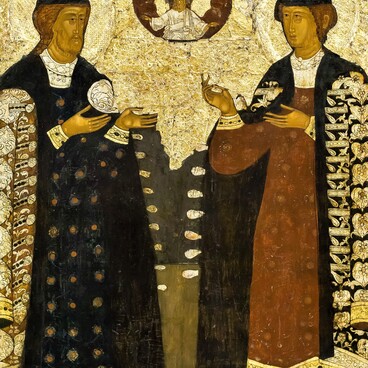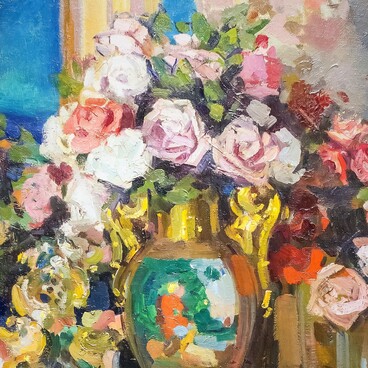St. Nicholas the Wonderworker is one of the most venerated saints in the Christian culture. He was archbishop from the city of Myra in Lycia known for his numerous miracles. Nowadays people pray to him, asking to protect them from trouble and help in their travels.
The museum collection contains twenty-eight icons that were created at different times. One of the most distinctive ones is the image of Nicholas the Wonderworker that comes from the Zilantov Holy Dormition Monastery in Kazan, founded by Tsar Ivan the Terrible in 1552.
In 1877, Platon Zarinsky — a researcher from Kazan — published ‘Ecclesiastical Antiquities of Kazan’, where he described two icons of the winter church of the Zilantov Monastery with one of them being the image of St. Nicholas the Wonderworker. In Zarinsky’s opinion, the key features of this icon were “decorations along the icon borders and edges” and “vivid colors”.
The icon was created by an unknown painter in the second half of the 17th century. The style of this image of St. Nicholas the Wonderworker from the Zilantov Monastery confirms its antiquity: the icon depicts a characteristic eye shape, a thin nose, an expansive forehead and strands of hair above it, and is also defined by a rich and contrasting color scheme.
The combination of unusual panel processing methods contributes to the icon’s unique qualities. The painter tried to imitate a metal revetment by using several types of ornamental carvings on the borders and the background. At the same time, the vegetative ornament of a wheat field in the background correlates with the saint’s eyebrows depicted in the form of wheat spikes.
The pictorial space of the nimbus is filled with a vegetative pattern, reminiscent of the multicolored ornaments found in decorative panels, which were used to cover the templon of rows of the iconostases. Templon (from the Greek τέμπλον meaning “temple, altar barrier”) is a wooden beam of the iconostasis used for installing icons and decorated with floral or geometric patterns. The Trinity Cathedral featured a chronicle (inscription) on its templons about the dedication of the church. Such ornaments on the saint’s nimbus can also be found in rare Balkan icons (the 14th century Athos icon from the collection of the State Russian Museum), as well as Old Russian ones (the 1294 icon by Alexa Petrov, from the collection of the State Novgorod Museum-reservation). Ornate halos are more common in the sculptural images of St. Nicholas of Mozhaysk.
To this day, art experts have not yet found other similar icons that could be distinguished by the same ornateness and artistic techniques.
The museum collection contains twenty-eight icons that were created at different times. One of the most distinctive ones is the image of Nicholas the Wonderworker that comes from the Zilantov Holy Dormition Monastery in Kazan, founded by Tsar Ivan the Terrible in 1552.
In 1877, Platon Zarinsky — a researcher from Kazan — published ‘Ecclesiastical Antiquities of Kazan’, where he described two icons of the winter church of the Zilantov Monastery with one of them being the image of St. Nicholas the Wonderworker. In Zarinsky’s opinion, the key features of this icon were “decorations along the icon borders and edges” and “vivid colors”.
The icon was created by an unknown painter in the second half of the 17th century. The style of this image of St. Nicholas the Wonderworker from the Zilantov Monastery confirms its antiquity: the icon depicts a characteristic eye shape, a thin nose, an expansive forehead and strands of hair above it, and is also defined by a rich and contrasting color scheme.
The combination of unusual panel processing methods contributes to the icon’s unique qualities. The painter tried to imitate a metal revetment by using several types of ornamental carvings on the borders and the background. At the same time, the vegetative ornament of a wheat field in the background correlates with the saint’s eyebrows depicted in the form of wheat spikes.
The pictorial space of the nimbus is filled with a vegetative pattern, reminiscent of the multicolored ornaments found in decorative panels, which were used to cover the templon of rows of the iconostases. Templon (from the Greek τέμπλον meaning “temple, altar barrier”) is a wooden beam of the iconostasis used for installing icons and decorated with floral or geometric patterns. The Trinity Cathedral featured a chronicle (inscription) on its templons about the dedication of the church. Such ornaments on the saint’s nimbus can also be found in rare Balkan icons (the 14th century Athos icon from the collection of the State Russian Museum), as well as Old Russian ones (the 1294 icon by Alexa Petrov, from the collection of the State Novgorod Museum-reservation). Ornate halos are more common in the sculptural images of St. Nicholas of Mozhaysk.
To this day, art experts have not yet found other similar icons that could be distinguished by the same ornateness and artistic techniques.



